Abstract
The relative stabilities of several cis- and trans-hydrindanones were compared using both isomerization experiments and MM2 calculations. The generally believed rule that cis-hydrindanones are more stable than trans-isomers is applicable, but is not always true. This review introduces examples, mainly from studies in our laboratory, to explain these facts.
1. Introduction
Hydrindanones are important intermediates in bioactive natural product synthesis [1,2]. cis-Hydrindanones are widely considered to be more stable than the corresponding trans-isomers and this is partly because C/D-trans steroid ketones at the C-15 position can isomerize to the corresponding cis isomers with base treatment [3]. However, the stability of hydrindanones is now known to depend on the ring system. For example, the trans-derivative 1t can be epimerized into the cis-derivative 1c (the suffix “c” denotes cis and “t” trans for the ring junction) by a simple isomerization reaction. Allinger discussed the relative energies of both cis and trans isomers calculated by MM2 [3]. Thus, 1c was more stable than 1t, as shown in Scheme 1 (the figures in the parentheses are heat of formation values as calculated by MOPAC6). We have been interested in this matter and attempted to determine why cis-isomers are so stable. This review describes broad examples of this isomerization and discusses the stability of hydrindanone derivatives, including our own findings.
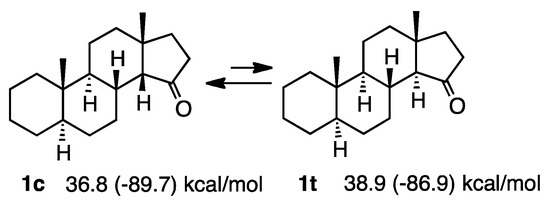
Scheme 1.
Relative stability of the simple steroid 1.
2. Results and Discussion
2.1. Steroid Ketones
Two conformations were identified in the cis-isomers in rings C and D of steroids, while only a rigid conformation existed in the trans-isomer. This was mainly attributed to the methyl group at the juncture position adopting an axial or equatorial orientation in the cis-isomer. However, only the axial conformation existed in the trans-isomer, which inevitably contributed to its instability. The methylated compound 2c was more stable than 2t, demonstrating that the additional methyl group had negligible effect on the relative stability of this system (Scheme 2) [3]. However, the isopropyl group reversed the relative stabilities of 3c and 3t because the methyl group of the isopropyl group strongly interacted with the juncture methyl group in the cis-isomer 3c, although the heat of formation of 3c was less than that of 3t [3]. The equilibrium ratio was 61:39 in compounds 4c and 4t, in favor of the cis-isomer 4c [3]. In the case of compounds 5c and 5t, the ratio was 99:1 in equilibrium [3].
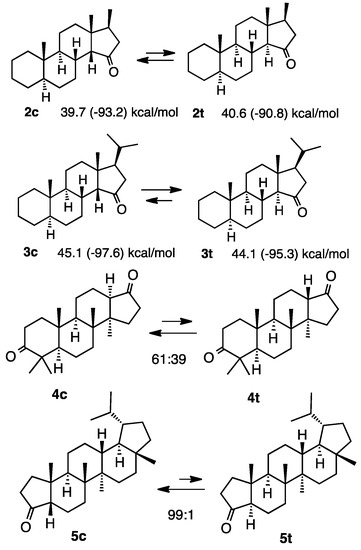
Scheme 2.
Relative stabilities of simple steroids 2–5.
2.2. Simple 4-Hydrindanones
As shown in Scheme 3, several hydrindanones are known to isomerize to cis-isomers very easily. Ratios have been determined using base-catalyzed isomerization experiments. Structures have mainly been established by derivatization into hydrazones and X-ray crystallographic analyses. Therefore, the findings obtained appear to be reliable. Thus, we calculated the steric energies of both isomers by MM2 combined with CONFLEX, which was developed by Goto and Osawa to determine out the global minimum conformation [4,5]. The steric energy calculated in this study is shown in Scheme 3; the simplest example, 6c (19.4 kcal/mol) and 6t (18.9 kcal/mol), did not follow the calculation (6c:6t = 76:24) [6]. The ratio of isomerization was reversed to the prediction. This also occurred for compounds 9c and 9t. This incompatibility was attributed to non-bonded interactions of substituents including hydrogen atoms with the carbonyl group; however, this has not yet been verified [7].
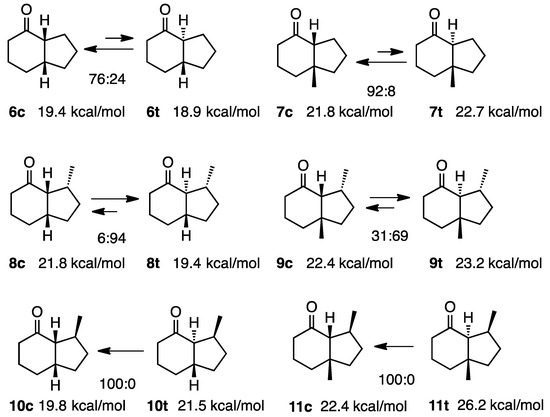
Scheme 3.
Relative stabilities of cis- and trans-4-hydrindanones 6–11.
2.3. Dimethyhydrindanones
In the course of the total synthesis of isovarelenenol, we examined the relative stabilities of hydrindanones, as depicted in 12c and 13c (Scheme 4). Kitagawa reported that the ketone derived from the natural product 12c very easily isomerized to the trans-isomer 12t; therefore, we avoided acidic or basic conditions in order to examine the side chain of isovarelenenol in more detail [8]. After the successful synthesis of dimethylhydrindanone 12c by hydrogenation of the hydrindenone, the cis-isomer 12c very easily isomerized to the trans-isomer 12t with a base treatment [9]. Since we had the isomer 13c, it was also treated with a base to completely isomerize it to 13t. The MM2 calculation revealed a marked difference in the steric energies of 12c and 12t (4.5 kcal/mol). However, this difference was only 0.5 kcal/mol between 13c and 13t.
Paquette reported that the cis ketone 14c yielded the trans-isomer 14t with a base treatment [10]. The calculation indicated that there was a 1.7 kcal/mol difference between these ketones, which was understandable because 14c was similar to 12c and 13c.

Scheme 4.
Relative stabilities of cis- and trans-4-hydrindanones 12–14.
2.4. Isopropylketones
In the case of 15c, the cis isomer was more stable than the trans-isomer 15t, and this was supported by the MM2 calculation (Scheme 5). However, an almost 1:1 mixture was obtained by the equilibration of 16c and 16t. These results were expected by the MM2 calculation revealing only a 0.7 kcal/mol difference [11].

Scheme 5.
Relative stabilities of cis- and trans-isopropylketones 15 and 16.
2.5. Simple 1-Hydrindanones
In the case of 1-hydrindanones, in which the ketones are in five-membered rings, the simple ketones 17c and 17t existed in a ratio of 3:1 in equilibrium; however, the calculation indicated that 17t was more stable (only 0.4 kcal/mol) [12,13]. cis-Hydrindanones generally have two conformations such as 17c-s and 17c-n (suffix “s” denotes the steroid form and “n” the non-steroid form) as in the case of cis-decalin, while the trans-isomer 17t has only one rigid conformation (s 6 and 7). Therefore, the cis isomers exhibit one of two conformations, which is energetically more stable. The calculation indicated that the non-steroid conformation 17c-n was more stable at 1.0 kcal/mol than 17c-s. In this case, the calculation fitted the experimental results. The introduction of a double bond to this system pushed the equilibrium to 52:48, although the calculation suggested that the stability of the trans isomer 18t was markedly greater than that of 18c at 2.1 kcal/mol. The methylated ketones 19 and 20 agreed with the results of the calculation, in favor of trans-isomers. There are two studies for ketone 19, the ratios being 25:75 and 18:82, respectively [13,14]. However, the stability of the diastereoisomer 21c was markedly greater than that of the corresponding trans-isomer 21t [14]. Other examples of diastereoisomers 22 and 23 show us interesting phenomena (Scheme 6). The compound 23c was the only isomer that existed in equilibrium, while the ratio for 22c was 56:44, and the energy difference between these two compounds was 2.5 kcal/mol, in favor of 22c. This situation was completely reversed in the case of 24 and 25. Since the tert-butyl group always adopts an equatorial conformation in the case of 24t, the tert-butyl group is forced into an axial position and, hence, this isomer cannot exist (24c:24t = 100:0). This situation can be more clearly understood by the conformations shown in Scheme 7 [14].
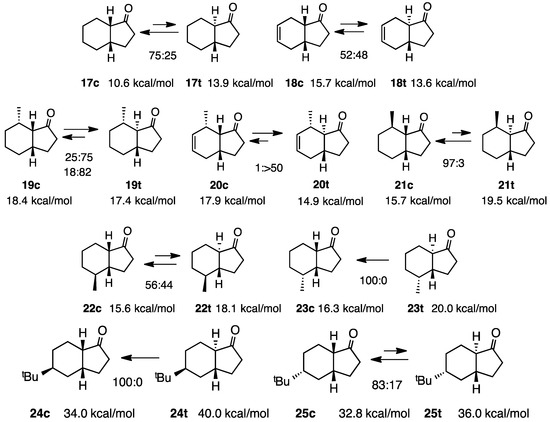
Scheme 6.
Relative stabilities of cis- and trans-1-hydrindanones 17–25.
2.6. 4-Hydroxy-1-hydrindanones
We previously described cyclization reactions into hydrindanones using samarium diiodide. The followings are the derivatives prepared by our new methodology [15]. The relative stabilities of these ketones were examined by isomerization with K2CO3 in MeOH under reflux overnight (both cis and trans isomers were subjected to the equilibration reaction to get the same ratio). Equilibrium was examined by GC and the structures were established by 2D NMR analyses including NOESY. The calculation of 26c and 26t revealed a 0.8 kcal/mol difference (Scheme 8 and Scheme 9). However, base-catalyzed isomerization indicated that the cis-isomer was more stable than the trans-isomer. This discrepancy was previously encountered in the case of 17 and 18. The diastereoisomer 27c was more stable than the trans-isomer 27t at 0.5 kcal/mol and the experimental results showed that the ratio was 27c:27t = 69:31.

Scheme 7.
Conformations of compounds 22-25.

Scheme 8.
Relative stabilities of cis- and trans-4-hydroxy-1-hydrindanones 26 and 27.
The equilibrium cis:trans ratio for the ethylated derivative 28 was similar to that observed for 26, with the cis epimer predominating (Scheme 10 and Scheme 11) [16]. Whereas the cis epimer was computed to be the more stable in 28, the trans epimer 26 was computed to be the more stable in contrast to the observed equilibrium ratio. Although the cis epimers were strongly favored at equilibrium in 29 and 30, very little diffence in energy between the epimers was found by MM2.
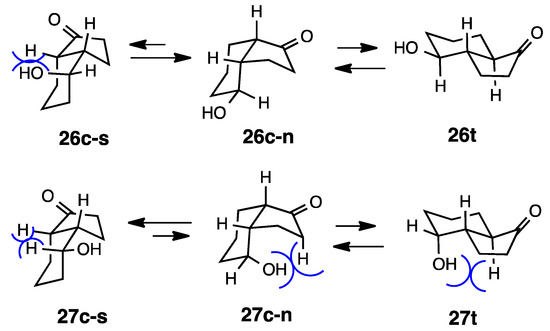
Scheme 9.
Conformations of cis- and trans-4-hydroxy-1-hydrindanones 26 and 27.
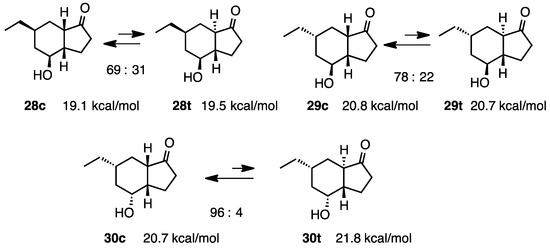
Scheme 10.
Relative stabilities of cis- and trans-4-hydroxy-1-hydrindanones 28–30.
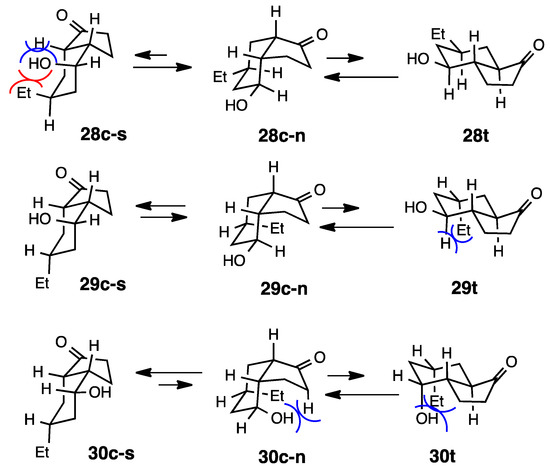
Scheme 11.
Conformations of cis- and trans-4-hydroxy-1-hydrindanones 28–30.
If there were two methyl groups at the C-3 position, the compound 31c did not agree well with the calculation. In contrast, ketone 32t was more stable than the cis isomer 32c, as was also the case for 34 (Scheme 12) [15].
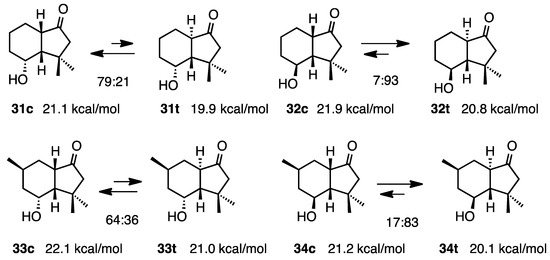
Scheme 12.
Relative stabilities of cis- and trans-4-hydroxy-1-hydrindanones 31–34.
We succeeded in synthesizing coronafacic acid (41) using samarium diiodide-induced reductive cyclization into hydridanones starting from compound 35 (Scheme 13). We used acid or base-catalyzed isomerization twice, as shown in Scheme 13; compound 36 isomerized to the trans isomer during acid-catalyzed ketalization and the base-catalyzed isomerization of compound 38 into 39 was achieved. In this synthesis, the initial product mixture of 36 was not purified. However, they all finally converged to the desired isomer [16].
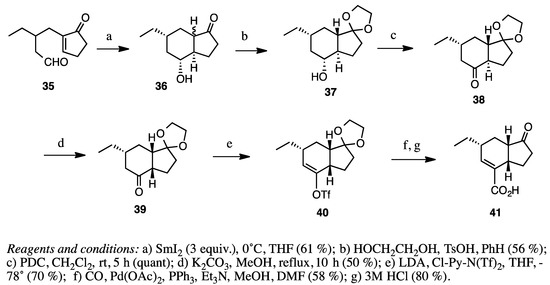
Scheme 13.
Synthesis of coronafacic acid (41).
2.7. Fused with a Cyclobutane Ring
Denmark et al. reported the stability of tricyclic ketones fused with the cyclobutanes, 42c and 42t, and 43c and 43t (Scheme 14) [17]. Both compounds were predominant in the cis-fused isomers at ratios of 94:6 and 75:25, respectively. These values matched the calculated steric energies; the calculated differences were 4.1 and 3.7 kcal/mol, respectively. These compounds appeared to resemble hydrindanones, as shown in Scheme 6.

Scheme 14.
Relative stabilities of cis- and trans-tricycloketones 42 and 43.
3. Conclusions
The stabilities of cis-hydrindanones have been considered to be markedly greater than those of the trans-isomers. However, as discussed in this review, some trans-hydrindanones are more stable than the corresponding cis-isomers, as demonstrated by base-catalyzed isomerization experiments and MM2 calculations (please note that in some cases the latter do not follow the experimental results). The kinds of substituents, the positions and orientations, and thus the conformations, can all affect the stability of the system. Therefore, calculations are advised for the requisite system and base-catalyzed experiments will provide the relevant answers.
Acknowledgments
The authors express their sincere thanks to the students in this laboratory engaged in these projects and also to Drs. Masakazu Sono and Katsuyuki Nakashima for their help and discussions. We are also grateful for the financial support from Tokushima Bunri University and a Grant-in-Aid for Scientific Research from JSPS (13672245, 09672181, 01540462).
Conflicts of Interest
The authors declare no conflict of interest.
References and Notes
- Defaut, B.; Parsons, T.B.; Spencer, N.; Male, L.; Kariuki, B.M.; Grainger, R.S. Synthesis of the trans-hydrindane core of dictyoxetane. Org. Biomol. Chem. 2012, 10, 4926–4932. [Google Scholar] [CrossRef] [PubMed]
- Yue, G.; Huang, X.; Liu, B. Progress in the total syntheses of trans-hydrindane-containing terpenoids. Chin. J. Org. Chem. 2013, 33, 1167–1185. [Google Scholar] [CrossRef]
- Allinger, N.L.; Tribble, M.T. Conformational analysis-LXXX. The hydrindanone ring system. Tetrahedron 1972, 28, 1191–1202. [Google Scholar] [CrossRef]
- Goto, H.; Osawa, E. Corner flapping: A simple and fast algorithm for exhaustive generation of ring conformations. J. Am. Chem. Soc. 1989, 111, 8950–8951. [Google Scholar] [CrossRef]
- Goto, H.; Osawa, E. An efficient algorithm for searching low-energy conformers of cyclic and acyclic molecules. J. Chem. Soc. Perkin Trans. 2 1993, 187–198, MMFF94S and BARISTA Ver. 1.3.2 interface software were used in these experiments. [Google Scholar]
- Peterson, P.E.; Leffew, R.L.B.; Jensen, B.L. Studies of the ketone obtained from the ozonolysis of vitamin D. Molecular mechanics calculations for it and related hydrindanones. J. Org. Chem. 1986, 51, 1948–1954. [Google Scholar] [CrossRef]
- Cicero, B.L.; Weisbuch, F.; Dana, G. Conformational analysis and stability of substituted 4-hydrindanones. A thermodynamic and magnetic resonance (1H and 13C) study. J. Org. Chem. 1981, 46, 914–919. [Google Scholar] [CrossRef]
- Kobayashi, M.; Yasuzawa, T.; Kyogoku, Y.; Kido, M.; Kitagawa, I. Three new ent-valerenane sesquiterpenes from an Okinawan soft coral. Chem. Pharm. Bull. 1982, 30, 3431–3434. [Google Scholar] [CrossRef]
- Tori, M.; Ikawa, M.; Sagawa, T.; Furuta, H.; Sono, M.; Asakawa, Y. Synthesis of isovalerenenol, a sesquiterpene alcohol isolated from a soft coral and their stability of related hydrindanone derivatives. Tetrahedron 1996, 30, 9999–10010. [Google Scholar] [CrossRef]
- Galemmo, R.A., Jr.; Paquette, L.A. Contrasting directed-aldol reactivity of a pair of epimeric trimethyl silyl enol ethers. J. Org. Chem. 1985, 50, 1768–1770. [Google Scholar] [CrossRef]
- Matlin, A.R.; Agosta, W.C. Four isomeric 7-isopropyloctahydro-4H-inden-4-ones. J. Chem. Soc. Perkin Trans. 1 1987, 365–368. [Google Scholar]
- House, H.O.; Rasmusson, G.H. Perhydroindanone derivatives. II. Stability relationships. J. Org. Chem. 1963, 28, 31–34. [Google Scholar] [CrossRef]
- Fringuelli, F.; Pizzo, F.; Taticchi, A.; Halls, T.D.J.; Wenkert, E. Diels-Alder reactions of cycloalkenones. 1. Preparation and structure of the adducts. J. Org. Chem. 1982, 47, 5056–5065. [Google Scholar] [CrossRef]
- Jones, T.K.; Denmark, S.E. Silicon-directed Nazarov reactions III. Stereochemical and mechanistic considerations. Helv. Chim. Acta 1983, 66, 2397–2411. [Google Scholar] [CrossRef]
- Sono, M.; Nakashiba, Y.; Nakashima, K.; Tori, M. Cyclization into hydrindanones using samarium diiodide. J. Org. Chem. 2000, 65, 3099–3106. [Google Scholar] [CrossRef] [PubMed]
- Sono, M.; Hashimoto, A.; Nakashima, K.; Tori, M. Total synthesis of coronafacic acid through 6-endo-trig mode intramolecular cyclization of an enone-aldehyde to a hydrindanone using samarium(II) iodide. Tetrahedron Lett. 2000, 41, 5115–5118. [Google Scholar] [CrossRef]
- Denmark, S.E.; Habermas, K.L.; Hite, G.A. Silicon-directed Nazarov cyclizations. Part V. Substituent and heteroatom effects on the reaction. Helv. Chim. Acta 1988, 71, 168–194. [Google Scholar] [CrossRef]
© 2015 by the authors. Licensee MDPI, Basel, Switzerland. This article is an open access article distributed under the terms and conditions of the Creative Commons Attribution license ( http://creativecommons.org/licenses/by/4.0/).